RV Winterizing... Is It Really All That Necessary?
To A Minimum Next Spring!

Some of us have limited options on this matter of surviving a cold wet season, and some of us just have to prioritize our calendar and leave town... and I'm sure there are a bunch of people in between these extremes. Besides, what does it mean to to do an RV winterizing anyway?
Can RV winterizing mean that you are just going to pack-up and move to a warmer environment? Or does it mean that you are staying put and will require some type of preparation against cold weather?
Maybe it won't get so cold where you are located... you may just have issues with critters wanting to make a home out of your rig when it is not in use. Your RV winterizing my be simply to prevent this.
Class C Motorhome in a cold climate.
If you are knee deep in snow and like it that way... that means you may be a skier of some type... down hill or cross country. Heck, you may really like ice fishing. If so, you may have already purchased your rig with heated tanks and triple paned windows. If not, you can perform some aftermarket additions like energy saving window insulation to help keep the cold in check.
Another thing that you can do that is right at the top of the list would be to investigate a more efficient propane heater. You can also add extra spray insulation to the rig. This spray-on that would go under the chassis area, or may want to add a couple of simple inserts that will protect the roof vents from heat loss.
Bottom line, there are options out there that enable comfortable cold weather activities. If your rig is big enough, you could even put in a small fireplace with a gas heating element. It just depends on your individual tastes and what you want to do.
Of RV Winterizing Your Rig, You Need To Have A Plan
What if you want to just park the thing, but snow and ice are coming your way? Different scenarios have different solutions. Let’s break things down a bit and attempt to clarify this subject of RV winterizing.
There Are A Couple Of Things That
You Should Pay Attention To
To begin with I’m not going to assume that you want to simply park your Class C Motorhome and let winter come your way. If this is the situation however, there are a couple of things that will need to be accomplished before the cold weather comes. Simply click on the following link to get a more detailed overview of this process. You will need to insure that your various water pipes, valves and holding tanks do not freeze!
Also here are some ideas on how to prepare the engine, drive-train, and tires for harsh winter conditions... and you will not want to overlook your batteries.
Class C Motorhome... we cannot be held responsible for any damages.
Just Not In Our Class C Motorhomes
Critters can be very opportunistic... that is a polite way of saying that they can be a pain in the butt! So what can we do to protect ourselves from these invasive creatures?
I don't think that all winterized rv's will have every insect, rodent, or spider known to man trying to make it their cozy home. But, you will probably have at least one or two different issues with these pests.
In my area of Sacramento, CA, I have issues with mud dauber wasps. These are the black and yellow wasps that have thread-like waists... not fat like a bee.

The good news is that these things rarely sting... if left alone. They will, however, attack if you are attempting to destroy their nests. They are solitary. That is, a queen will build her hard mud nest and stay isolated.
They have no social groups like the yellow jacket. Yellow jacket's are very protective of their colonies and will attack just because they can... you might say yellow jackets have an attitude.
The bad news is that mud daubers like to build in places that cause motorhome owners problems... like heater vents. My mud daubers like to build their nest in my awning enclosure. However, they can choose just about any spot that is convenient for them.
Your best bet for eradication is to simply apply a commercial aerosol spray into their nest. This is best done at night, and then you want to leave the area. You could get stung, so cover up your body as best as you can.
Oh! Another thing... during the cold season in the winter months you can remove their nest without harm... the problem for me is that we don't really have a 'cold' winter in Sacramento... it just rains a sometimes.:>)
In Your Recreational Vehicle
Mice, or even rats, can be an issue... heck, so can skunks, squirrels and raccoons. I have all of the above where I live, but they have yet to mess with my motorhome. These bigger critters will go through screens to get into your rig. So if you leave a window open to help vent the motorhome, be aware that you may have uninvited guests.
If any of these animals get into your rig, they will build a nest by using your curtains, pillows, cushions, etc. They do this by chewing them up and organizing the material according to their taste.
You will probably have the most issues with mice. These little buggers can get into just about anywhere. If they can stick their head in through a hole their bodies will soon follow!
About the only thing you can do is to get under your rig and perform part of your RV winterizing by plugging any hole that you can put your little finger in. It is not that big of a deal... just get a good flashlight, and you should only have to do this once... if done properly. A small can of Great Stuff Big Gap Filler should do the trick
Let's see, oh yeah... spiders! Spiders like warm dry places too! I'm thinking that you will not have a real issue with them getting into your rig. At least they haven't done that with me.
But, they do like the undercarriage, and they seem to be attracted to propane. This stuff is kind of like catnip to spiders. So, they hang around the propane tank.
If you take your tank out of the rig when you RV winterizing, be sure to put caps on your hoses, or you may find a wad of spider webs next spring. I really don't think the motorhome guys will ever have a need to do this. However, if you have a travel trailer, it may be something that you would want to do. Every situation is different...
Ants may be an issue. Like all of the above, they will be looking for food. So, remove anything that looks like it could be a food source. Left over cookies is something that is pretty obvious and must be removed. However, toothpaste, or even soap could be attractive to some critter. Be safe, take EVERYTHING out of the rig.
The best way to prevent an ant invasion is to use an ant poison like Amdro Ant Block or an Orthene WP. It seems if ants ignore the Amdro, then Orthene does the trick.
Unfortunately, it is a trial and error kind of thing. The point is, use an ant block that takes the ant poison back to the colony and kills the queen. If you do not do this... you will have continual ant problems.
Into Your Rig
There is also the possibility of an invasion of mold contamination or fungus. There are lots of things to think about, but actually, most of the stuff that needs to be done can be accomplished in a couple of hours at most.
You can also have a professional maintenance facility perform an RV winterizing check list for your home on wheels. This is not a bad option if you want peace of mind.
Mold is something that can sneak up on you... and you really don't want to have the stuff around. It is much easier to prevent mold contamination than to clean it up after it has established itself.
All Class C Motorhome owners have a high awareness (and dread) of water leaks resulting from rain and/or snowy conditions. This type of leak will most likely cause a dry-rot condition. Condensation is another moisture bearing event that needs to be looked at. If you button up a Class C Motorhome for the winter and do not allow for moisture build up, you could have a ‘fuzzy’ motorhome by next spring.
All you need to do to prevent this is to keep the air dry inside your home on wheels. This can be accomplished by simply using a product like Dri-Z-Air
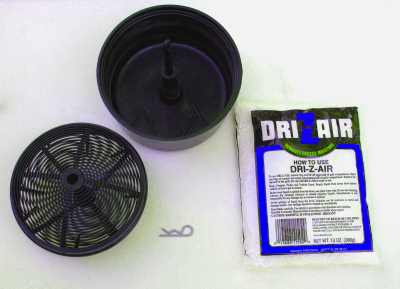
These products help accomplish the RV winterizing process and can be found at most RV supply stores... they even have the stuff at WalMart. Simply follow the manufacturer’s instructions, and they will draw the unwanted moisture out of the air that is caused by condensation.
Another idea, if you have easy access to your rig, is to put some type of heat source in the unit. A simple incandescent bulb may do the trick. A small heater could also work, but it is risky business due to the potential fire hazard. This type of solution does need to be monitored closely.
I typically finish off my RV winterizing procedure by relying on chemical absorbents like those mentioned above. It works just fine. You have to replenish the supply and get rid of the accumulated moisture on a regular basis. How long it lasts just depends on how much moisture is in the air.
Some folks recommend a plastic tarp or cover to help protect your rig. Well, in theory, this makes sense. However, if you use a material that cannot breathe, you will have created a moisture trap that will create condensation.
This will cause… guess what… fungus and mold. So, just be sure that if you do cover your rig, make sure it can breathe so the condensed moisture will evaporate!
To sum this up, you simply cannot park your Class C Motorhmome at the end of the season and expect to have it in good working order next spring. It's okay to let your rig "go to sleep", but you do not want it to go into a "coma" due to neglect!

Return To Top Of Page
Leave Should We Winterize Our Motorhome During the Fall Season? And Return To RV Maintenance: Now That You Have Been Using Your Class C Motorhome...
Leave Should We Winterize Our Motorhome During the Fall Season? And Return To The Class C Motorhome: How To Achieve The Maximum RV Lifestyle! Page
YOUR STORIES
1995 Tioga Montara
Had a Leak - Ouch!
A Simple Way To Put An Electrical Thermostat On A Small Space Heater
In A Truck Camper!
A Great Destinaton, With An Unexpected Outcome!
Test Link
Below: For An Alternative Destination... A Four Mile Hike Around Sugar Pine Reservoir
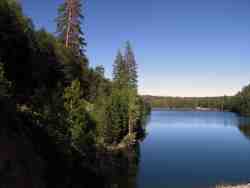
A Good Place To Begin The Joshua M. Hardt Memorial Trail Is At The Dam. This 3.5 Mile Trail Is Good For Foot Traffic And Bicycles... No Motorized stuff
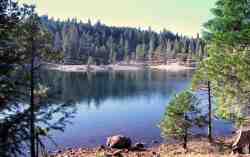
The Manzanita Day Use Area Is A Good Place To Sit And Watch The Wind
Play With The Water!
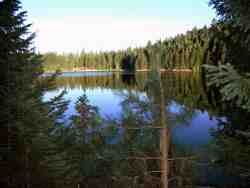
Another View From The Joshua M. Hardt Memorial Trail... Morning and Evening Are The Best Times To Hike This Trail. The Still Reflections Will Capture Your Attention
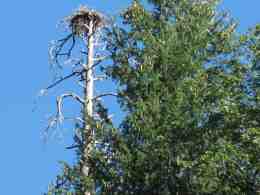
You May Want To Bring A Camera... There Are Large Birds Of Prey High In The Ski






